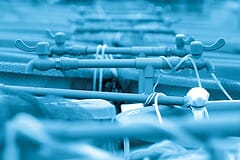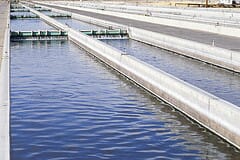Farm Killers come in all forms, but the most common ones are usually linked to poor RAS design and facility planning and inadequate operating procedures.
Disease in one form or another is the major “Farm Killer” most should be worried about
Disease prevention and incorporation of tools to prevent disease from becoming an issue are often not given the level of priority they should until problems arise.
Good operations evaluate where their weaknesses lie and proactively take measures to mitigate risk and to prevent potential problems from becoming problems. Taking a reactionary approach to disease in RAS or having an attitude that antibiotics and chemicals are the best insurance policy, is a recipe for eventual disaster.
Such an approach can work when managing flow thru systems, but it has no place when producing fish in RAS.
A common mistake made by newcomers to RAS, especially those from flow thru and open ocean net pen farming backgrounds, is that of underestimating the pathogen compounding effects of some RAS designs and not appreciating some of the limitations of managing a disease in RAS once disease has been introduced. 
When translated to making business decisions on RAS components, equipment, and operating protocols to include, such a lack of understanding has and will significantly increase the risk of failure.
Underestimating the risk of disease
Specific pathogen free certification does not mean that the fish are disease free and it doesn’t even mean that it is free of the specific disease being certified.
Such certification is only for the specific pathogens being tested and other pathogen causing agents may be present and are likely present if buying fry rather than eggs. Eggs can be disinfected to eradicate horizontally transmissible diseases, whereas fry cannot be treated at levels to do the same.
With fry, the farm receiving them will inherit many of the microorganisms of the farm from in which they are coming; many of which are not part of the specific pathogen free screening. Most will not be an issue, but others, under the right conditions specific to RAS can be.
For marine fish, due to larval production stage’s requirement for live feeds, the risk an unknown pathogen being part of the live fish delivery is high. As virulent fish pathogens go, saltwater seems to have much more of them and greater considerations are needed for saltwater facilities as compared to freshwater.
Specific pathogen testing is only to detect pathogens to a certain prevalence level and the certification states that the presence of a specific pathogen is unlikely, however there is still a chance that the specific pathogen is actually present, but just not detected.
In flow-thru farms, a near negligible level of infective agents may be a non-issue as it will likely be flushed away long before it can build to disease causing levels. 
In RAS, the ability of potential pathogens to reproduce and multiply to infective levels are much greater, and for this reason, extra steps need to be taken depending on the type and source of stock being used.
Risk of disease establishment is one difference between successful and less successful applications of aquaculture
New ventures that are inadequately prepared may enjoy a “honeymoon” period and prosper for a few years, but eventually problems will arise when the proper security measures are not taken.
Juvenile production facilities which are fully emptied and disinfected before restocking continually have their “honeymoon” clock reset.
This breaking of disease establishment in addition to the high selling price of juveniles is part of the reason that RAS has had much success in this sector of aquaculture.
For continuous production systems, the extra RAS components and procedures for reducing risk or even adding system capacity to allow for system resetting, may be costly, but the investment very well could be the difference between long term success and a disaster that puts one out of business.
Although RAS has some special risks related to disease, it also extra capabilities and tools that can be incorporated to make failure from disease unlikely. It is just a matter of knowing what the tools are and how to use them.




